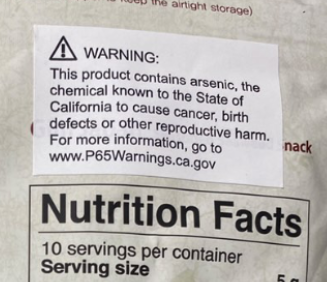A Recap on America’s Most Controversial Warning Label, Proposition 65
Proposition 65 was meant to inform people of the risks associated with products that they might purchase, but is it effective, and how can it improve?

ca.gov, Public domain, via Wikimedia Commons
Here is the logo associated with the official website for Proposition 65.
When was the last time you saw something with a Proposition 65 label on it? A month ago? Last week? Today, even? Or have you never noticed the tiny signage and if you did, didn’t question it?
Proposition 65 reads with some iteration as follows, “WARNING: This product may contain chemicals known to the State of California to cause cancer, birth defects or other reproductive harm.” Proposition 65 is slapped on almost everything that we come across and this leads to the question of whether Proposition 65 is no longer a useful tool or if it was a useful device to begin with.
Proposition 65, also referred to as Prop65 or simply p65, “became law in November 1986, when California voters approved it by a 63-37 percent margin,” according to the official California Office of Environmental Health Hazard Assessment (OEHHA). Although Proposition 65 is better known for its cancer warnings, this piece of legislation was originally produced to prohibit businesses from deliberately releasing toxins into California’s water sources and contaminating groundwater— thus leading to Proposition 65’s official name of “The Safe Drinking Water and Toxic Enforcement Act of 1986.”
Consequently, Proposition 65 demands California to release a list of chemicals that are known to cause detrimental effects like cancer or birth defects. This list is a living document and currently includes around 900 chemicals that range from Acrylamide to Zileuton. Once new research is published, some of the previously listed chemicals are “delisted” as they are considered to not be as dangerous as they once were thought to be.
Since the birth of Proposition 65, the law has expanded to include warning labels in 1988. And more recently, in 2018 these tags required a triangular warning sign, at least one of the listed chemicals in the merchandise for each medical condition it may cause (like a chemical for cancer and one for reproductive harm if applicable), and a link to the Proposition 65 website where buyers can read more about the potential dangers of the 900 possible carcinogens.
If a business does not adhere to the regulations outlined by Proposition 65, they may be sued and incur up to a $2,500 fine per day. This fee has influenced some companies to reformulate their products to adhere to Proposition 65’s guidelines and avoid having an ominous label that may deter their customers. Arguably, the entire purpose behind Proposition 65 was to make merchandise safer (which it has to some extent), not provide pesky warnings and grounds to million dollar lawsuits.

The first time that I saw a Proposition 65 label was while I was eating some nori maki arare (rice cracker rolls wrapped in seaweed). The warning left me appalled, and I threw out the snack, wondering how I could eat something that could potentially lead me to an untimely death. Looking back, I probably overreacted and wasted money and food. Nowadays, I do examine packaging before buying items, but I’m pretty desensitized to seeing Proposition 65 signages. This sentiment appears to be shared among many online as a quick Google search yields many results of frustrated consumers who are sick of seeing the caution symbol.
I couldn’t help but wonder why Proposition 65 was on items that I purchase in New York City when it should theoretically only apply to California. Upon researching further, I discovered that these signs are on products that are meant to be sold within the borders of California, but creating two different packages for the same product can be costly for companies, especially smaller brands that can’t afford to foot these costs.
Some may say that Proposition 65 as a whole is excessive in the fact that a plethora of products have Proposition 65 because the OEHHA lists a lot of problematic chemicals. However, it is undeniable that Proposition 65 has a significant impact on California and the United States as a whole. OEHHA notes that, partially due to Prop 65, “trichloroethylene, which causes cancer, is no longer used in most correction fluids.” This change in formula affects consumers nationwide and possibly worldwide. Proposition 65 can be a major catalyst for change only when used properly and in moderation. If nearly everything comes with a warning label, no one is going to bother reading them; the warnings need to be more selective and on products that are going to pose an incredibly significant risk towards consumers.
Proposition 65 is not just found on labels of heavily processed items like potato chips; they are also in commodities like nori snacks that have trace levels of heavy metals like arsenic, lead, cadmium and mercury because of the water that the seaweed was harvested from. Nonetheless, reducing exposure to as many possible carcinogens should be a priority since cancer and reproductive harm can severely impact your quality of life.
“Half the time I look at products in supermarkets, they always have this label that says that [this product] causes cancer or reproductive harm, but I would like to know anyway,” said Carys Chan ’25.
Room for Improvement
The aforementioned amendments are well-thought out but are becoming outdated. Typing out the entire link to the generic Proposition 65 website can be tedious for consumers. Rather than just adding the link to the official generic Proposition 65 website, manufacturers should also be required to add a scannable QR code in the warning decals to direct shoppers to the relevant articles on the Proposition 65 website that pertain to the listed chemicals in the product — for example, this official page on the dangers of benzene. In addition, this QR page can explain in depth how to properly use and handle a product to avoid risk of contacting the carcinogen to buyers. This single action could potentially decrease the fear mongering aspect of Proposition 65 while simultaneously making it easier for the public to gather information, especially if they are in a rush while waiting at the checkout line.
An average buyer does not spend hours researching the ingredients of a package of cookies they plan on buying. Proposition 65 labels may be effective in scaring potential buyers into doing more research that they typically wouldn’t do by directing them to the problematic chemical and warning them of risks they may incur by using or consuming a certain product. But this is only the case if the shopper sees the label — Proposition 65’s efficiency lies in its visibility and clarity. The public should not have to jump through hoops to make better, more informed choices.

Additionally, as mentioned earlier, Proposition 65’s 2018 modification requires a (yellow) triangle caution symbol. The color of or the number of exclamation points in the caution symbol can be changed in association with the health risk that a certain product poses to the consumer (for example, red for high risk, orange for moderate risk and yellow for low risk). This change can help consumers learn more at a quick glance.
Furthermore, the law stipulates that the warning decal must be at least font size 6, have the word “warning” in bold and capitalized, and if it is for a food product, the sign needs to be boxed. All of these requirements are excellent, but can be improved by setting a minimum size for the warning label that scales with depending on the size of the object, in order to increase its prominence.
While the public may have a negative perception of Proposition 65, it is not too late for modifications to be made in the name of more accessibility.
“Half the time I look at products in supermarkets, they always have this label that says that [this product] causes cancer or reproductive harm, but I would like to know anyway,” said Carys Chan ‘25.
Arianna Hwang is an Editorial Editor for ‘The Science Survey.' She enjoys reading and writing articles as she believes it is important to hear the opinions...
Grace Mao is a Managing Editor for 'The Science Survey,' where she edits her peers’ articles across various sections before they are published online....










